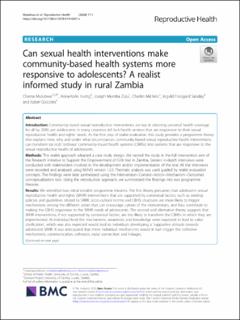| dc.contributor.author | Mulubwa, Chama | |
| dc.contributor.author | Hurtig, Anna-Karin | |
| dc.contributor.author | Zulu, Joseph Mumba | |
| dc.contributor.author | Michelo, Charles Cheembo | |
| dc.contributor.author | Sandøy, Ingvild Fossgard | |
| dc.contributor.author | Goicolea, Isabel | |
| dc.date.accessioned | 2021-05-31T08:53:41Z | |
| dc.date.available | 2021-05-31T08:53:41Z | |
| dc.date.created | 2020-10-01T13:02:53Z | |
| dc.date.issued | 2020 | |
| dc.Published | Reproductive Health. 2020, 17 (1), 1-?. | |
| dc.identifier.issn | 1742-4755 | |
| dc.identifier.uri | https://hdl.handle.net/11250/2756998 | |
| dc.description.abstract | Introduction
Community-based sexual reproductive interventions are key in attaining universal health coverage for all by 2030, yet adolescents in many countries still lack health services that are responsive to their sexual reproductive health and rights’ needs. As the first step of realist evaluation, this study provides a programme theory that explains how, why and under what circumstances community-based sexual reproductive health interventions can transform (or not) ‘ordinary’ community-based health systems (CBHSs) into systems that are responsive to the sexual reproductive health of adolescents.
Methods
This realist approach adopted a case study design. We nested the study in the full intervention arm of the Research Initiative to Support the Empowerment of Girls trial in Zambia. Sixteen in-depth interviews were conducted with stakeholders involved in the development and/or implementation of the trial. All the interviews were recorded and analysed using NVIVO version 12.0. Thematic analysis was used guided by realist evaluation concepts. The findings were later synthesized using the Intervention−Context−Actors−Mechanism−Outcomes conceptualization tool. Using the retroduction approach, we summarized the findings into two programme theories.
Results
We identified two initial testable programme theories. The first theory presumes that adolescent sexual reproductive health and rights (SRHR) interventions that are supported by contextual factors, such as existing policies and guidelines related to SRHR, socio-cultural norms and CBHS structures are more likely to trigger mechanisms among the different actors that can encourage uptake of the interventions, and thus contribute to making the CBHS responsive to the SRHR needs of adolescents. The second and alternative theory suggests that SRHR interventions, if not supported by contextual factors, are less likely to transform the CBHSs in which they are implemented. At individual level the mechanisms, awareness and knowledge were expected to lead to value clarification’, which was also expected would lead to individuals developing a ‘supportive attitude towards adolescent SRHR. It was anticipated that these individual mechanisms would in turn trigger the collective mechanisms, communication, cohesion, social connection and linkages.
Conclusion
The two alternative programme theories describe how, why and under what circumstances SRHR interventions that target adolescents can transform ‘ordinary’ community-based health systems into systems that are responsive to adolescents. | en_US |
| dc.language.iso | eng | en_US |
| dc.publisher | BMC | en_US |
| dc.rights | Navngivelse 4.0 Internasjonal | * |
| dc.rights.uri | http://creativecommons.org/licenses/by/4.0/deed.no | * |
| dc.title | Can sexual health interventions make community-based health systems more responsive to adolescents? A realist informed study in rural Zambia | en_US |
| dc.type | Journal article | en_US |
| dc.type | Peer reviewed | en_US |
| dc.description.version | publishedVersion | en_US |
| dc.rights.holder | Copyright 2020 The Authors | en_US |
| dc.source.articlenumber | 1 | en_US |
| cristin.ispublished | true | |
| cristin.fulltext | original | |
| cristin.qualitycode | 1 | |
| dc.identifier.doi | https://doi.org/10.1186/s12978-019-0847-x | |
| dc.identifier.cristin | 1836171 | |
| dc.source.journal | Reproductive Health | en_US |
| dc.source.40 | 17 | |
| dc.source.14 | 1 | |
| dc.relation.project | Norges forskningsråd: 248121 | en_US |
| dc.relation.project | Norges forskningsråd: 223269 | en_US |
| dc.identifier.citation | Reproductive Health. 2020, 17, 1 | en_US |
| dc.source.volume | 17 | en_US |

